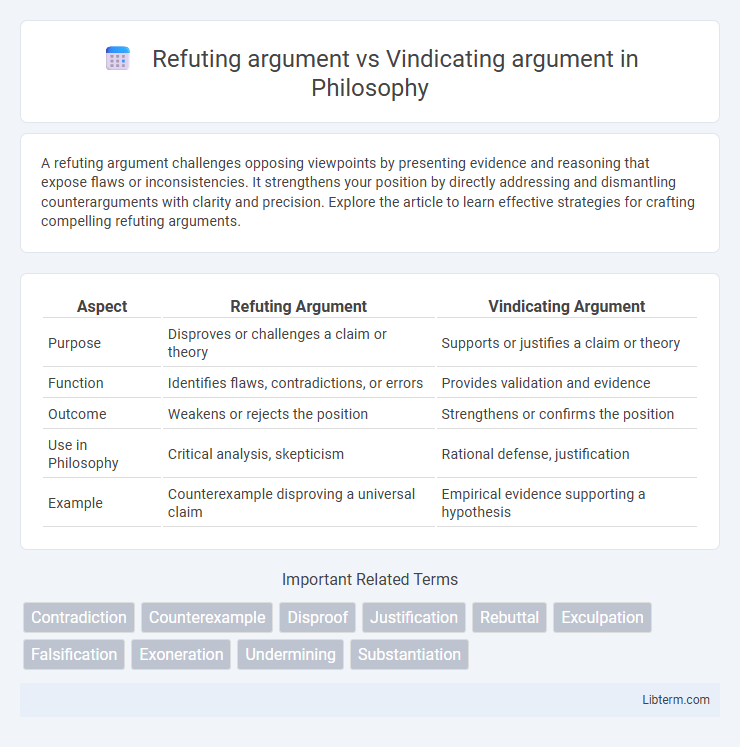A refuting argument challenges opposing viewpoints by presenting evidence and reasoning that expose flaws or inconsistencies. It strengthens your position by directly addressing and dismantling counterarguments with clarity and precision. Explore the article to learn effective strategies for crafting compelling refuting arguments.
Table of Comparison
| Aspect | Refuting Argument | Vindicating Argument |
|---|---|---|
| Purpose | Disproves or challenges a claim or theory | Supports or justifies a claim or theory |
| Function | Identifies flaws, contradictions, or errors | Provides validation and evidence |
| Outcome | Weakens or rejects the position | Strengthens or confirms the position |
| Use in Philosophy | Critical analysis, skepticism | Rational defense, justification |
| Example | Counterexample disproving a universal claim | Empirical evidence supporting a hypothesis |
Understanding Refuting and Vindicating Arguments
Refuting arguments directly challenge the validity of a claim by presenting evidence or reasoning that disproves or contradicts it, thus undermining the opposing position. Vindicating arguments support and justify a claim by providing logical explanations or evidence that reinforce its truth or credibility. Understanding refuting and vindicating arguments is crucial for critical thinking, enabling effective evaluation and construction of persuasive discourse in debates, academic writing, and everyday reasoning.
Key Differences Between Refutation and Vindication
Refuting argument aims to disprove or invalidate an opposing claim by presenting contradictory evidence or reasoning, highlighting logical flaws or inaccuracies. Vindicating argument seeks to defend or justify a position, reinforcing its validity through supportive evidence and reasoning to establish credibility. The key difference lies in the intent: refutation targets disproving opposition, while vindication focuses on confirming and strengthening the argument's legitimacy.
Defining Refuting Arguments: Purpose and Structure
Refuting arguments aim to disprove or challenge opposing claims by presenting evidence that undermines the validity of those claims. Their structure typically includes identifying the opposing argument, providing counter-evidence, and explaining why the original claim is flawed or incorrect. The purpose of refuting arguments is to weaken opposition and strengthen one's own position through logical rebuttal and critical analysis.
Defining Vindicating Arguments: Purpose and Structure
Vindicating arguments aim to provide justification or support for a claim by presenting evidence and logical reasoning that confirm its validity. Their structure typically includes a clear thesis, relevant premises, and conclusions that reinforce the claim's credibility. The primary purpose of vindicating arguments is to persuade the audience of the truth or acceptability of an assertion through coherent and substantiated proof.
Common Techniques in Refutation
Common techniques in refutation include identifying logical fallacies, presenting contradictory evidence, and exposing inconsistencies in the opposing argument. Effective refutation often involves careful analysis of the opponent's claims and using factual data or expert testimony to undermine their validity. Techniques such as reductio ad absurdum and counterexamples are frequently employed to systematically dismantle the opposing position.
Common Techniques in Vindication
Common techniques in vindicating arguments include presenting new evidence that supports the original claim, clarifying misunderstandings or misinterpretations that led to criticism, and providing logical reasoning to reinforce the validity of the initial position. Vindication often involves systematically addressing each point of dispute, demonstrating consistency with established facts and theories. Employing expert testimonies and empirical data can strengthen the defense and rebuild credibility effectively.
Examples of Refuting Arguments in Practice
Refuting arguments directly challenge the validity of a claim by presenting evidence or reasoning that disproves it, such as using statistical data to contradict a false assertion about climate change. In legal contexts, refuting arguments often involve providing alibis or counter-evidence that undermine the prosecution's case. Scientific debates frequently feature refuting arguments when researchers present experimental results that invalidate a previously accepted hypothesis.
Examples of Vindicating Arguments in Practice
Vindicating arguments often appear in legal settings where a defendant provides evidence that supports their innocence, such as alibi testimony or expert analysis that disproves the prosecution's claims. In academic debates, a vindicating argument might involve presenting new data or interpretations that restore credibility to a criticized theory, like DNA evidence validating a disputed historical claim. Scientific research uses vindicating arguments by replicating experiments under controlled conditions to confirm original findings, thereby reinforcing the validity of previous conclusions.
Impact on Persuasion: Refutation vs Vindication
Refuting arguments directly challenge opposing claims by exposing flaws or contradictions, which strengthens persuasion through critical examination and undermining counterarguments. Vindicating arguments reinforce and justify a position by providing supportive evidence and logical reasoning, building credibility and trustworthiness. The impact on persuasion depends on context: refutation appeals to skeptical audiences requiring doubt to be addressed, while vindication convinces through affirmation and validation of the argument.
Choosing the Right Approach: When to Refute and When to Vindicate
Choosing the right approach between refuting and vindicating arguments depends on the context and objective of the discussion. Refuting is effective when disproving false claims or correcting misunderstandings with clear evidence and logical reasoning. Vindicating is appropriate when defending a position or idea by reinforcing its validity and addressing doubts through supporting data and explanations.
Refuting argument Infographic

 libterm.com
libterm.com